This activity falls with the setting sun but in the hush of twilight a different set of birds emerge from the shadows. The Owls. Owls are remarkable creatures that have many impressive adaptations that help them live and hunt under the pale light of night. We are fortunate to have Great Horned Owls, Barred Owls and Eastern Screech Owls living on or around the LREC property. Here we will shed some light on the mysterious world of our owl friends.
ADAPTATIONS FOR HUNTING
As you may have noticed, owls have large eyes and if our eyes were to be just as big, they would be the size of softballs!

These huge eyes gather in a great deal of light, allowing the birds to see 10–100 times greater than humans do in poor light. Like humans, owls have forward-facing eyes that give them an increased depth perception when hunting and looking for places to perch. But unlike humans, owl’s eyes are fixed in their sockets and they must move their heads to focus on different objects. To compensate for this limitation, owls have an extra bone in their neck that allows them to rotate their heads 270 degrees in either direction. So that means, if an owl were to turn his head to the right, he could continue to turn his head until it rested on his left shoulder!
An owl’s sense of hearing is just as important as his sight and is so keen that it is possible for this bird to hunt by sound alone. The disc of feathers around an owl’s face gathers in and funnels sound into the ear canals, which are located just behind the eyes.
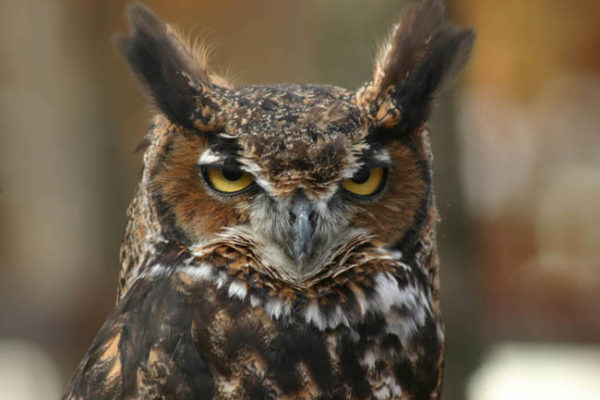
The ear openings are asymmetrically placed on the owl’s head, giving the bird a sense of three-dimensional hearing. When a potential prey item is spotted, the owl will bob his head up and down and from side to side, taking in sound from all directions as he triangulates the precise location of his next meal.
Once the owl has sized up his prey item, he will swoop down in silence on that unsuspecting rabbit or mouse. You may be wondering how that creature did not hear the owl’s approach and the answer lies in the feathers. Each feather on the owl’s wings have softened serrated edges and a fuzzy upper surface, muffling sound as these feathers move through the air.
An owl’s talons are also adapted for successful hunting. These birds have zygodactyl feet which means that the outer toe on each foot can swivel back and forth, giving the owl the option to have 2 toes in the front and 2 toes in the back, providing a strong, even grip on its squirming prey. When the owl has captured his prey, he will either tear it apart with his powerful beak or swallow it whole, gulping down the prey headfirst. The owl’s digestive system will take the bones and fur of its prey and compact it into a pellet, which the owl will regurgitate at a later time.
BREEDING
Owls, particularly the Great Horned Owls, are probably the earliest nesting birds in the St. Louis area. Great Horned Owls begin courtship as early as November and begin nesting in January and February.
Adult Great Horned Owl
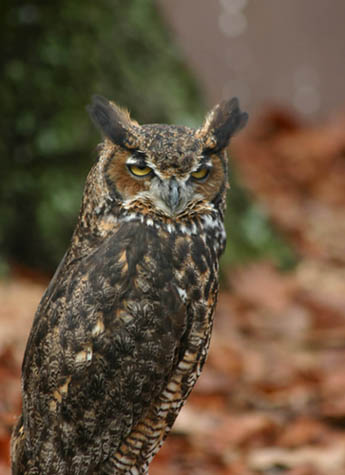
Young Great Horned Owl
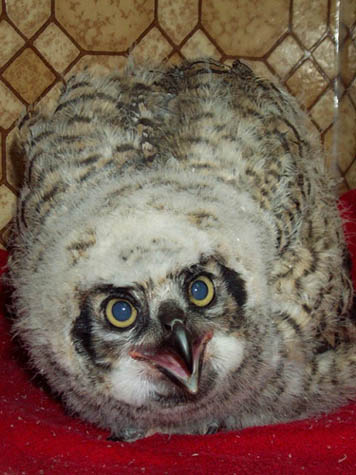
The Barred Owls begin breeding in February and March.
Adult Barred Owl
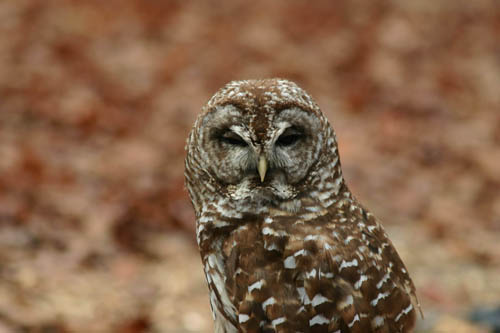
Young Barred Owl
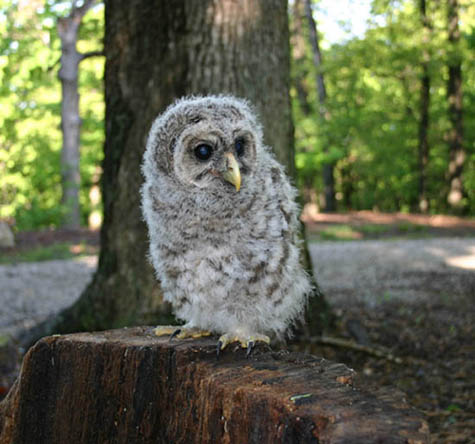
Screech Owls nest later in the spring, starting in March and continuing through the month of May.
Adult Eastern Screech Owl (Red Phase)
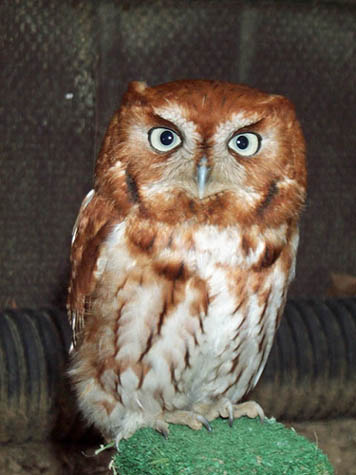
Young Eastern Screech Owl
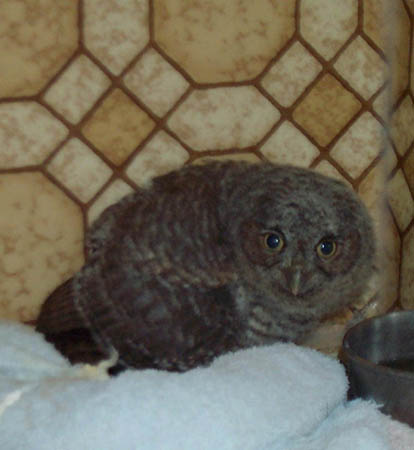
The owls do not build their own nests; rather they will reuse a nest, such as an abandoned hawk or squirrel’s nest. Great Horned Owls prefer a platform-type nest over a cavity nest but Barred and Screech Owls will use tree cavities and nestboxes to raise their young. Owls lay their eggs every 1–2 days but will not begin incubation until after the second egg is laid. The male primarily delivers food to the nest but the female will assist her mate once the owlets grow older. There is some variation in the length of time the different owlet species remain in the nest, but most of these young birds begin fledging about a month after they have hatched. The owlets will rely on their parents for food for several weeks after they have left the nest.
CHALLENGES TO SURVIVAL
There are several obstacles the owl must overcome in order to survive and a big challenge they face today are pesticides. An owl may not be directly affected by the consistent consumption of a poisoned mouse or insect, but the indirect effects of pesticides can be costly. Abnormal eggs, small clutches and owlets with birth defects are some of the secondary effects of pesticide use. The widespread use of pesticides also diminishes the owl’s constant food source. Habitat loss, automobile traffic and outdoor cats are other factors that affect owl mortality. Loss of habitat affects the availability of nesting sites for the owls and it is not uncommon for owls to collide with cars while hunting at night. Cats are problematic because they kill owlets and the smaller owl species.
There are many ways people can help the owls survive. Retaining large trees and even old buildings is helpful because owls often use these structures as nesting sites. You can also build or purchase nest boxes for Eastern Screech Owls and Barred Owls. Limiting the use of pesticides and other poisoned baits, keeping cats indoors and reporting people who shoot or steal owls to Operation Game Thief are ways you can make life easier for these birds.
This entry has only scratched the surface on the mysterious world of the owls. Be sure to check out the books, nestcams and websites listed below to learn more about these fascinating birds!
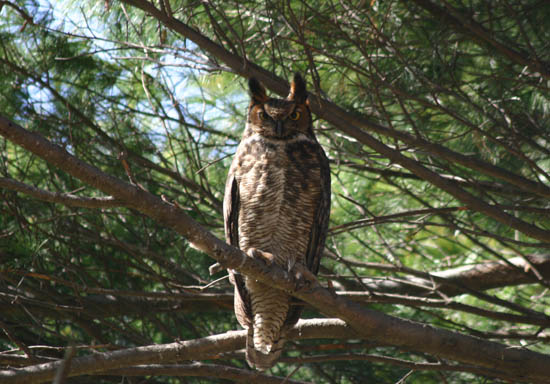
Eastern Screech Owl Nest cam
Chris’ Eastern Screech Owl Nest Box Cam
Andy and Julia’s Owlcam
Great Horned Owl Nest Cam
Valmont Owlcam
CSUB NSM Webcam
MO Department of Conservation
Owls Found In Missouri
Owl Fact Sheet
Owl Pellets
Building Nest Boxes
Screech Owl Nest Box
Barred Owl Nest Box
RESOURCES
Baicich, Paul J, 1997, A Guide to the Nests, Eggs and Nestlings of North American Birds. New York: Academic Press.
Sutton, Patricia and Clay, 1994, How to Spot an Owl. Vermont: Chapters Publishing Ltd.
Sibley, David Allen, 2001, The Sibley Guide to Bird Life and Behavior. New York: Alfred A. Knopf Publishing.
The Missouri Department of Conservation
1 Comment.
A really great article with some really great pictures.